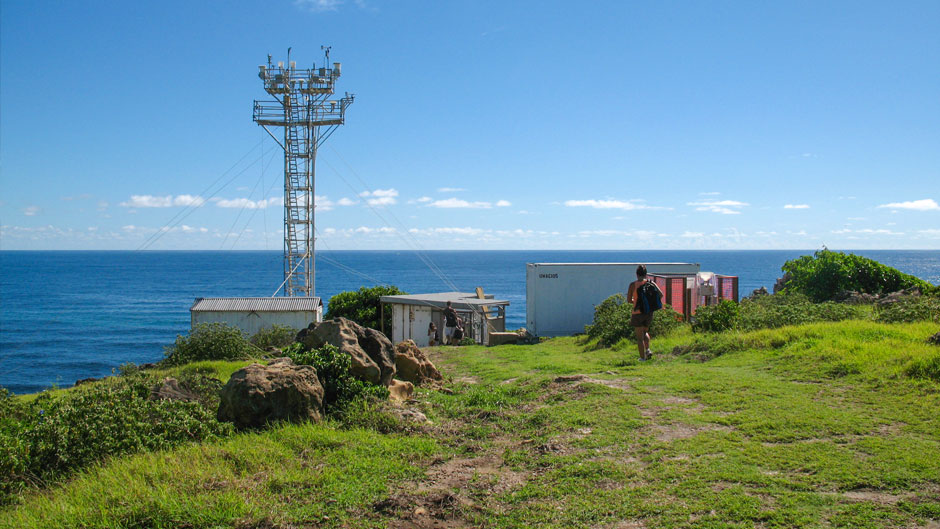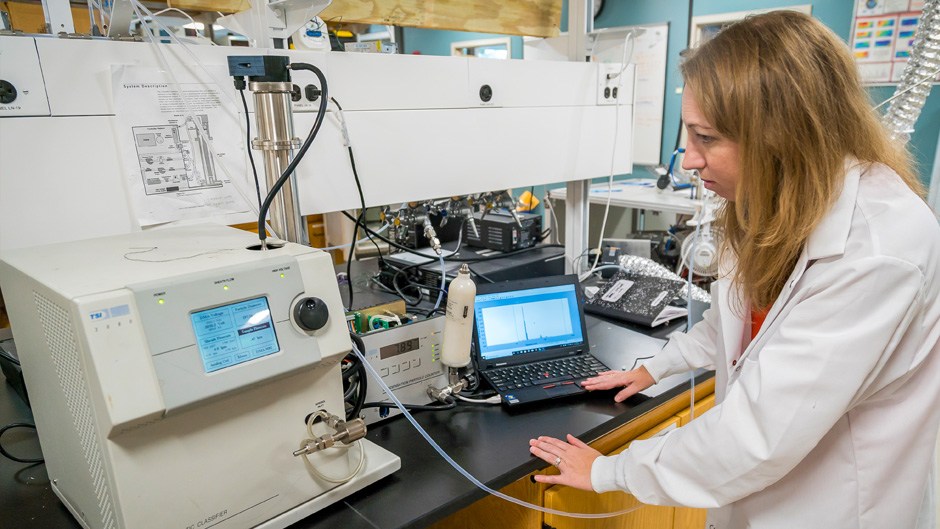The clear mesh filters mounted atop a 55-foot tower on a Barbados bluff always turn a dark hue of red after just a few hours of exposure to the elements—proof positive that dust from the Sahara, powered by strong winds, travels across the Atlantic to reach the Caribbean Basin and the Americas.
For decades, scientists at the University of Miami’s Barbados Atmospheric Chemistry Observatory (BACO) have collected dust samples in precisely this fashion, using instruments to study how the tiny particles affect clouds, climate, and air quality.
But for the longest time, researchers who have worked at and relied upon data generated by the facility have known that it could be something greater than simply a site that documents the transport of desert dust.
Now, a $1 million National Science Foundation grant will unlock its full potential.
“This funding is much more than an upgrade,” said Cassandra Gaston, the atmospheric chemist at the Rosenstiel School of Marine, Atmospheric, and Earth Science, who spearheaded the grant proposal that will refurbish the BACO site she has operated for the past three years.
“It’s really a rebirth, a reimagining,” she noted. “We’ll still deploy filters to look at African dust transport. But the new instruments we’re getting will allow us to take measurements we’ve never been able to do before.”
The facility’s 3½-story tower will be replaced. And a suite of new instrumentation—from a trace metal monitor to an aerosol chemical speciation device—will be brought in via cargo ship, allowing researchers to take measurements that improve climate models in real time and to study indicators of pollution, smoke, black carbon, and ocean emissions.

The new instruments, Gaston pointed out, will also allow scientists to carry out more studies on the health impacts of dust, such as its impact on pediatric asthma rates on the island. For years, researchers have tried to establish that link. But studies on the relationship have been rare. “Now, with the new instruments we’ll be getting, we’ll get a better handle on how dust transport events impact human health,” Gaston said.
Such studies will benefit not only the Caribbean but other areas as well. While Barbados is typically the first land mass Saharan dust will reach, the particles often travel further, even reaching the United States’ Gulf Coast during late spring and early summer.
Two years ago in early summer, for example, a plume of thick Saharan dust nearly 4,000 miles long made its way to Puerto Rico, Hispaniola, and Cuba before moving into the Gulf of Mexico, impacting those areas with high concentrations of particulate matter. Scientists nicknamed the massive plume the “Godzilla” dust event.
An upgraded BACO facility will attract researchers from across the University and from around the world, who will conduct research of their own. It will also fuel collaborations with Gaston’s research group as well as other scientists at the Rosenstiel School.
“This opens a multitude of doors,” she said of the NSF grant.
Tropical cyclone experts interested in studying how dust suppresses hurricane formation, public health researchers who want to know more about microbial life that hitch a ride on dust plumes, and environmental engineers who want to document the impacts of pollution are just a handful of the investigations an upgraded BACO could spawn.
“The instrument payload we’re getting is purposely designed to mirror that of a major initiative to fund air-quality monitoring measurements throughout the nation,” Gaston revealed. “And that means we’ll be able to inform a myriad of important air quality studies being conducted across the U.S.”
Paquita Zuidema, professor and chair of atmospheric sciences—who partnered with Gaston on the NSF grant proposal to upgrade the site and whose research focuses on the relationship of warm, shallow clouds to the large-scale environment—said an upgraded BACO will allow her to “puzzle out” how dust and smoke affect trade wind cumulus clouds.
“The processes governing trade wind cumulus clouds over Barbados are similar to what we experience in Miami during periods of fair weather,” Zuidema pointed out. “An improved understanding of these processes is important for more robustly predicting how such clouds will behave in an altered climate. Dust-cloud interactions can also act to either increase or compensate the effects of trade wind clouds on climate, and the datasets acquired through BACO will help articulate those.”
A revamped Barbados facility will directly impact research that will be conducted at the new University of Miami Center for Aerosol Science and Technology that officially launches early next year. The center will involve collaborations between faculty members and students in the College of Engineering’s Department of Chemical, Environmental, and Materials Engineering; the Rosenstiel School; and the Miller School of Medicine. It will study the way in which aerosols affect the environment, climate, and human health. And it also will concentrate on broader aspects of engineering applications of aerosol science such as nanoparticle technology.
Pratim Biswas, a renowned aerosol scientist and dean of the College of Engineering, envisions using the smaller aerosol-monitoring sensors from his lab in concert with newly installed instruments at the Barbados site to conduct air-quality studies of all kinds. “These distributed particulate matter sensors will allow mapping out the spatial and temporal distribution of aerosols and further allow integration with data from satellite-based systems,” he explained. His research group has already used sensors to study air quality in major cities in China, Taiwan, and India.
“BACO has generated a tremendous volume of data,” said Biswas, who partnered with Gaston on the NSF grant proposal to upgrade the site. “With the improvements, it’ll only get better.”
For Joseph Prospero, the legendary atmospheric scientist and Rosenstiel School emeritus professor who, in 1971, established the observatory at Ragged Point on the easternmost edge of Barbados, the impending upgrades are a dream come true.
“I had been trying for years to get the place refurbished,” he recalled. “It’s difficult to fund programs that are out on a limb, so to speak, as this wasn’t conventional research that we were doing.”
Back in the 1960s, it was Prospero and his colleague, Toby Carlson, who discovered the phenomenon of Saharan dust transport and the Saharan Air Layer, reporting their findings in leading scientific journals. “Today, when you turn on your TV in the evening to watch the weather report in the summer months, [meteorologists] talk about Saharan dust. It’s become part of routine forecasts,” Prospero said.
But as the observatory aged—at one point, sampling at the site was even discontinued—the important research Prospero and subsequent scientists conducted in Barbados was in jeopardy of being halted permanently.
“Now, the work that we’re continuing to do, looking at the relationship of Saharan dust to weather and to climate, is all the more important,” Prospero said.

